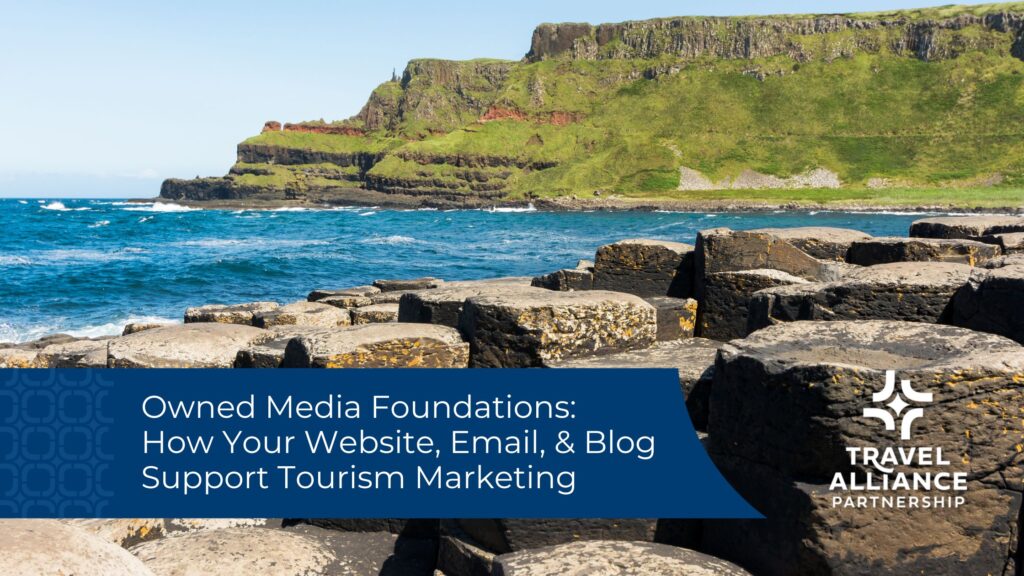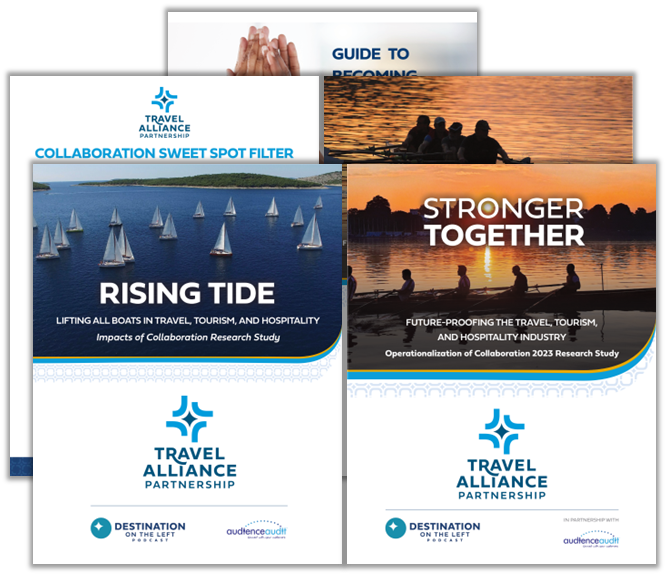Owned Media Foundations: How Your Website, Email, and Blog Support Tourism Marketing
Owned media is exactly what it sounds like — it’s yours. Your website, your email list, your blog — these are the channels where you have complete control over your message, your story, and your audience’s experience. No shifting algorithms, no rented space. Just a solid foundation you can build on, adapt, and grow over time. Your website, email, and blog are the owned media tactics that support every other channel in your plan. They create a home base that welcomes visitors in and keeps them coming back.

The Role of Owned Media in the PESO Model
Owned media is the foundation of the PESO model, developed by SpinSucks, that stands for Paid, Earned, Shared, and Owned. While paid, earned, and shared channels help attract and amplify your reach, it’s your owned channels that hold the story together. They’re the destination you guide people to, and the place where you control the narrative.
The Core Trio
Website: Your Digital Welcome Center
For visitors, your website is the front door to your destination or business — it’s where first impressions form and decisions to visit are made. For you, your website is “home base” for your messaging and campaigns. This is where your key messages can live in their pure form – not intepreted by a journalist, reinforced by an adoring fan, or clipped into a social media post. It’s also where everything points to: your ads direct to landing pages with CTAs, social posts link here and ideally media placements do, too.
Email Marketing: Your Direct Line to Fans and Visitors
Email lets you skip the middleman and speak directly to the people who want to hear from you, keeping your brand top of mind year-round. For as long as someone is subscribed to your newsletters, you can contact them. There is so much you can do with email marketing to make it stronger. If you’re not emailing your list yet, this is your sign to start. If you are, take a look at where you can improve with segmentation, changing the content mix or improving basic stats like open or click rates by adjusting your subject lines and content. An often overlooked metric, but one of the most important, is replies to emails. Marketers are turning toward authentic, personal content to better engage their audiences and earn responses from their subscribers.
Mystery Hill, a roadside attraction in North Carolina’s High Country, wants to attract both road trippers passing through as well as locals who can visit more frequently. We’re working with them to divide their email list by geography, so locals can get frequent updates on what’s happening, and visitors get content focused on planning their trip and what else they can do along the way.
Blog: Your Storytelling and SEO Powerhouse
A well-crafted blog connects with travelers through stories, answers their questions before they ask, and keeps search engines sending new visitors your way. Dig into all the great stories you have to tell about your experiences, partners, and events. If you have an active blog, look for where it’s aligned with your key messages, and which topics no longer fit (time to archive them). If your blog has gone stale, you don’t have to start over from scratch. Find a previous topic or two that aligns with your current messaging and refresh the content, check that the links work and publish the updated version with a new date.
Quick Audit Checklists
Unsure where to begin? Start here. Use these checklists to quickly audit your website, email, and blog — and uncover your next steps.
Website Audit
- Easy navigation: Can visitors find the most important information you want them to have in 3 clicks or less?
- Clear CTAs: Booking, contact information, or next steps are set on every page.
- Mobile-friendly: Look at the entire site using your phone instead of your computer. Does everything look like it should? Is it functional and easy to use on mobile?
- Load speed under 3 seconds: Faster sites keep visitors’ attention. If the site is bogged down with large images or videos, or worse yet – something in the code – visitors will lose interest and leave.
- Analytics tracking: Make sure Google Analytics is set up and monitored. If you’re running ads, you will need to incorporate the pixels or tracking APIs to make the most of your dollars.
Email Marketing Audit
- List health: You remove bounced or inactive subscribers regularly, and your list is growing.
- Frequency: You have a consistent, predictable schedule for sending emails.
- Engagement metrics: What’s your average open rate? Click rate? When is the last time someone replied to one of your emails?
- Content mix: Include a variety of promotional, educational, and inspirational content to keep your audience engaged and prevent email fatigue.
- Segmentation: Personalization through segmentation is great for your audience and your content. Group your lists by interest, location or behavior and send something that’s just for them.
Blog Audit
- Consistency: Posting consistently helps keep your website fresh, which is an SEO booster. TAP posts weekly, but most of our clients are on a monthly or twice-per-month cadence.
- Relevance: Align your content with your audience – their interests, needs and travel planning stages. Think seasonal guides, event round-ups, and partner highlights that align with current travel trends.
- SEO: Search Engine Optimization is constantly changing, but there are simple best practices that still help your content be found. Use keywords naturally in your headings, post content and meta descriptions. (Note: all eyes are on AI as the shift to GEO – the AI version of SEO – has already started. We’re just starting to see tips and tricks emerge.)
- Readability: Easy reading is the key. Tools like Hemingway Editor and Yoast give you a readability grade and recommendations to improve.
- Internal & External linking: Every blog will ideally include links throughout your own site, as well as a few links to external sources such as partner websites or articles.
- Content age: How old is your oldest blog post, does it need updating or archiving? Older posts can drag down SEO. Refresh them with new data, images, or examples.
- Duplicates: Are there repeated topics or posts that could be consolidated? Multiple posts on the same topic can compete in search. Combine them into one strong post to improve rankings.
Integration in Action
When your owned channels work together, the results multiply. For example, a paid ad campaign might drive traffic to a dedicated landing page on your website, which then adds visitors to your email list. That list receives a nurture series with helpful tips, linking to relevant blog posts that deepen engagement and inspire action.
Measuring Success
- Website KPIs: Users, pageviews, time on site, top pages. These show how well your site attracts and holds visitor attention.
- Email KPIs: Subscribers, open rate, click rate, list growth, responses. These indicate how engaged your audience is and how compelling your content feels.
- Blog KPIs: Traffic, social shares. These measure your reach and relevance.
Your marketing works best when it’s built on ground you own. Take a fresh look at your website, email list, and blog this week — even small improvements can make a big impact. And if you’re ready to turn your owned channels into a true growth engine, we’re here to help you map the strategy, sharpen the story, and connect the dots. Because when your foundation is strong, everything you build on top of it will reach further.
Author
Related Posts
Driving Visitation Through Culinary Tourism
When visitors come to a destination, they’re looking for experiences that feel authentic and unforgettable. Few things connect people—or capture the essence of a place—like…
Creating a Strategic Travel and Tourism Marketing Plan: A Step-by-Step Guide
Strategic marketing is about attracting the right people, at the right time, with the right message. A clear, strategic marketing plan is your blueprint for…
